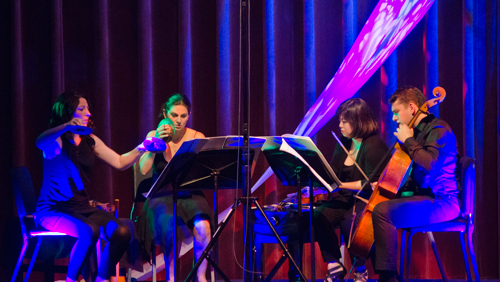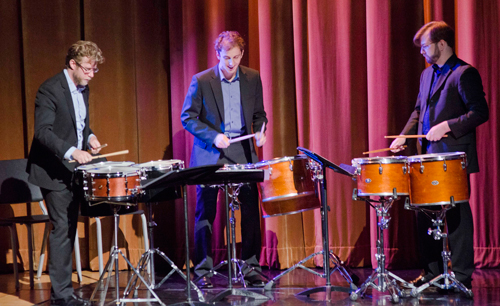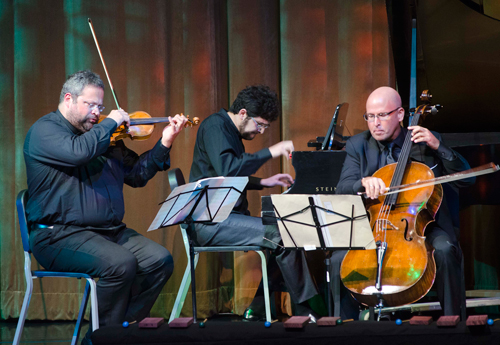by Mike Telin
Ghosts from the past, the present and the future were brought to life on Saturday, June 28 in Kulas Hall at the Cleveland Institute of Music. But these were not the ghosts made famous by Charles Dickens but rather, through a 4,000 year-old Chinese tradition, where humans, spirits of the past and future and nature communicate with one another. All of this happened during ChamberFest Cleveland’s spectacular production of Tan Dun’s Ghost Opera for String Quartet and Pipa, [Chinese lute] with Water, Stones, Paper and Metal. Commissioned by the Kronos Quartet nearly 20 years ago, ChamberFest added another dimension to the haunting work with the world premiere of inventive and stylistically sensitive choreography by Groundworks Theater artistic director David Shimotakahara.
Lasting 40 minutes, the work was inspired by the composer’s childhood memories of the shamanistic ghost operas of Chinese peasant culture. During the Opera’s five acts Tan Dun invokes the Past through a quotation from Bach’s Prelude in C-sharp minor from Book I of The Well-Tempered Clavier; monks and ancient Chinese traditions through the folk song Little Cabbage; and Shakespeare with an excerpt from the Tempest. The Present is represented by the string quartet and pipa, and the Future with the “Song of Paper.”
The composer directs the players to perform from six stations located around the stage. Paper, shadows and water basins each represent different time periods and spiritual realms. The music often consists of a series of notated patterns that are bounced from player to player. In addition to moving from station to station, a fair amount of improvising is also required. The players also perform on cymbals, rocks, paper and water gongs and their vocal talents are called upon through recitations of Shakespeare and shouts of Ya O Ya – Ya O – Ya!
Needless to say, Ghost Opera takes the musicians out of their comfort zones. Pulling off its theatrical aspects is as important to the success of the performance as the music, and violinists Amy Schwartz Moretti and Diana Cohen, violist Yura Lee, and cellist Gabriel Cabezas did so with remarkable confidence and stunning musical flair. The virtuosic pipa playing of Gao Hong and her innocent sweet singing of Little Cabbage were transfixing.
In the last two decades Ghost Opera has proven it can create its own drama as a musical composition, but the addition of David Shimotakahara’s choreography animated the spirits even further. Given that I had never seen a live performance of Ghost Opera, I was struck by how collaborative the choreography felt. It was as though Tan Dun had always intended it to be there. The choreography’s athleticism and romantic lyricism, a signature of Shimotakahara, was expertly realized by dancers Felise Bagley, Noelle Cotlier, Damien Highfield, Gary Lenington, and Annika Sheaff. Their lines during many unison movements were perfectly in sync with one another as well as with the music. The limber Annika Sheaff’s humorous duet with a wooden crate was a high point.
Dennis Dugan’s atmospheric lighting and costumes by Janet Rolick, Rebecca Russell and Ray Zander perfectly captured the otherworldliness of the production. It’s great that ChamberFest organizers didn’t shy away from taking on a challenge such as this. Their creation is certainly worthy of more performances in the future.
The theatrical nature of the evening was in evidence during the first half as well. Dugan’s lighting added an extra drama to percussionists Alex Cohen, Scott Christian and Luke Rinderknecht’s outstanding performances of the third movement, “Amores,” from John Cage’s Trio for Seven Wood Blocks, the third movement from Nebojsa Zivkovic’s Trio Per Uno and Alexandre Lunsqui’s Shi (food).
After a very brief pause and a shift to more ambient lighting, the concert continued with an extraordinarily dramatic performance by violinist Yehonatan Berick, cellist Robert deMaine and pianist Roman Rabinovich’s of Shostakovich’s Trio No. 2, Op. 67.
Throughout, the performers brought the appropriate amount of heroic muscle and thoughtful introspectiveness to the work’s evocative harmonic and rhythmic shifts, while tossing off difficult technical passages with ease. And although the players were capable of producing a very big sound, it was always stylish. After the final notes had faded, the players waited in silence before acknowledging the work’s conclusion. The silence eventually transformed into a thunderous ovation from the sold-out Kulas Hall audience.
Photos by Gary Adams.
Published on ClevelandClassical.com July 3, 2014.
Click here for a printable copy of this article.






